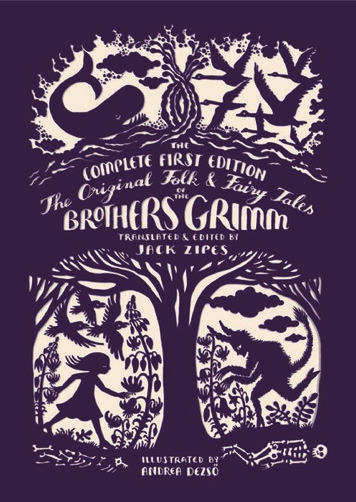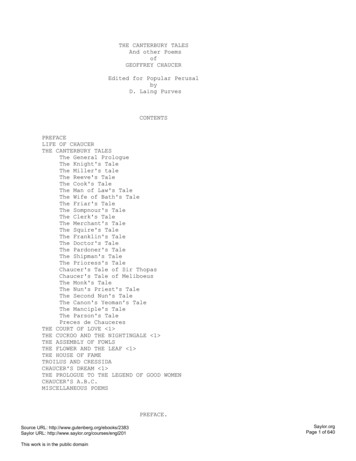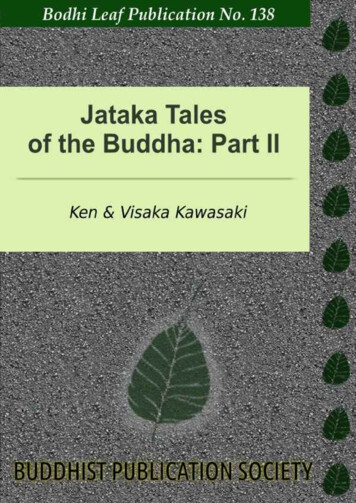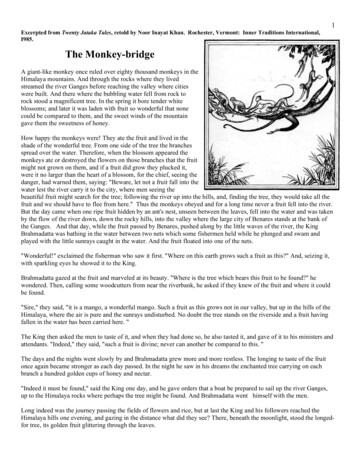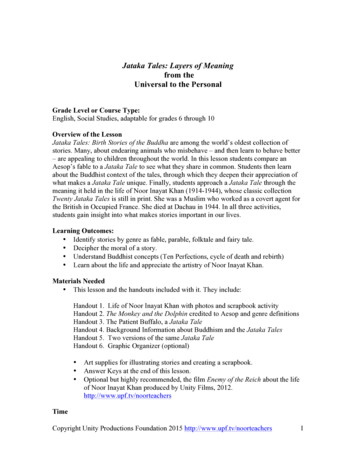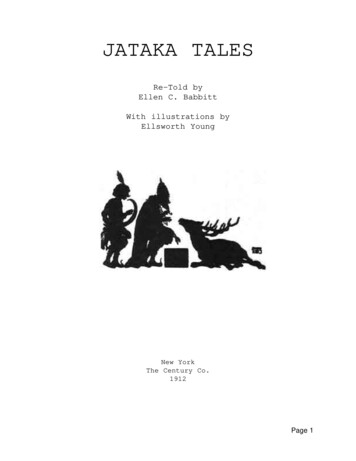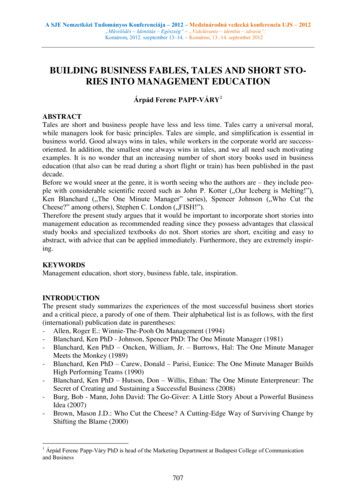
Transcription
A SJE Nemzetközi Tudományos Konferenciája – 2012 – Medzinárodná vedecká konferencia UJS – 2012„Művelődés – Identitás – Egészség“ – „Vzdelávanie – identita – zdravie“.Komárom, 2012. szeptember 13–14. – Komárno, 13.-14. september 2012BUILDING BUSINESS FABLES, TALES AND SHORT STORIES INTO MANAGEMENT EDUCATIONÁrpád Ferenc PAPP-VÁRY1ABSTRACTTales are short and business people have less and less time. Tales carry a universal moral,while managers look for basic principles. Tales are simple, and simplification is essential inbusiness world. Good always wins in tales, while workers in the corporate world are successoriented. In addition, the smallest one always wins in tales, and we all need such motivatingexamples. It is no wonder that an increasing number of short story books used in businesseducation (that also can be read during a short flight or train) has been published in the pastdecade.Before we would sneer at the genre, it is worth seeing who the authors are – they include people with considerable scientific record such as John P. Kotter („Our Iceberg is Melting!”),Ken Blanchard („The One Minute Manager” series), Spencer Johnson („Who Cut theCheese?” among others), Stephen C. London („FISH!”).Therefore the present study argues that it would be important to incorporate short stories intomanagement education as recommended reading since they possess advantages that classicalstudy books and specialized textbooks do not. Short stories are short, exciting and easy toabstract, with advice that can be applied immediately. Furthermore, they are extremely inspiring.KEYWORDSManagement education, short story, business fable, tale, inspiration.INTRODUCTIONThe present study summarizes the experiences of the most successful business short storiesand a critical piece, a parody of one of them. Their alphabetical list is as follows, with the first(international) publication date in parentheses:- Allen, Roger E.: Winnie-The-Pooh On Management (1994)- Blanchard, Ken PhD - Johnson, Spencer PhD: The One Minute Manager (1981)- Blanchard, Ken PhD – Oncken, William, Jr. – Burrows, Hal: The One Minute ManagerMeets the Monkey (1989)- Blanchard, Ken PhD – Carew, Donald – Parisi, Eunice: The One Minute Manager BuildsHigh Performing Teams (1990)- Blanchard, Ken PhD – Hutson, Don – Willis, Ethan: The One Minute Enterpreneur: TheSecret of Creating and Sustaining a Successful Business (2008)- Burg, Bob - Mann, John David: The Go-Giver: A Little Story About a Powerful BusinessIdea (2007)- Brown, Mason J.D.: Who Cut the Cheese? A Cutting-Edge Way of Surviving Change byShifting the Blame (2000)1Árpád Ferenc Papp-Váry PhD is head of the Marketing Department at Budapest College of Communicationand Business707
A SJE Nemzetközi Tudományos Konferenciája – 2012 – Medzinárodná vedecká konferencia UJS – 2012„Művelődés – Identitás – Egészség“ – „Vzdelávanie – identita – zdravie“.Komárom, 2012. szeptember 13–14. – Komárno, 13.-14. september 2012-Fenton, Richard - Waltz, Andrea: Go for No! Yes is the Destination, No is How You GetThere (2008)Fogg, John Milton: The Greatest Networker in the World (1992)Johnson, Spencer PhD: The Present: The Secret to Enjoying Your Work And Life, Now!(2003)Johnson, Spencer PhD – Wilson, Larry: The One Minute ales Person – The QuickestWay to More Sales With Less Stress (1984)Johnson, Spencer PhD – Johnson, Constance: The One Minute Teacher – How to TeachOthers to Teach Themselves (1986)Johnson, Spencer PhD: One Minute For Yourself – How To Manage Your Most ValuableAsset (1987)Spencer, Johnson PhD: Who Moved My Cheese? An Amazing Way to Deal with Changein Your Work and in Your Life (1998)Kotter, John PhD - Rathgeber, Holger: Our Iceberg is Melting! – Changing and Succeeding Under Any Conditions (2006)Lechter, Sharon L. - Reid, Greg S. - The Napoleon Hill Foundation: Three Feet fromGold: Turn Your Obstacles into Opportunities! (2009)Lundin, Stephen C., PhD - Paul, Harry - Christensen, John: FISH! – A Proven Way toBoost Morale and Improve Results (2000)Mandino, Og: The Greatest Salesman in the World (1968)Seiwert, Lothar: Die Bären-Strategie. In der Ruhe liegt die Kraft. (2005)Let us see these business fables, short stories, the provided management propositions, and theways they can be built into education.THE BUSINESS FABLES, TALES AND SHORT STORIESThe Christian SalespersonIt is not easy to tell what was the first book belonging to this genre, but it might be „TheGreatest Salesman in the World” by Og Mandino, published in 1968. The protagonist of thestory is Hafid, a camel boy, who – seeing the wealth of his boss – decides to become a salesman himself. He is assigned to sell a finely woven red robe in Betlehem. He tries to sell it, butdoes not succeed, and eventually covers a shivering baby with the precious robe. However,his boss sees a celestial sign, the bright star in Betlehem, and shares with him his greatest secret: ten scrolls, telling Hafid how to become a great salesman. The ten scrolls are actually tenprayers with several repetitions: for example, „I will act now” appears within a chapter 18times.Although this is also a short book, only about 100 pages long, the author suggests it should beperused for 10 months, always realizing and practising one of the chapters (scrolls). The bookapparently has great Christian influence as the baby he covers with the robe is Jesus, and atthe end of the story old Hafid delivers the ten scrolls to no one else but the Apostle Paul, making him the next greatest salesman.The formula of successAlthough the majority of tales are not related to religion, most of them aim to explore universal morals. Such an example is „Three Feet from Gold”, a book by Sharon L. Lechter andGreg S. Reid. The title of the book is a reference to a story in „Think and Grow Rich”, a workby Napoleon Hill. Namely, this book does nothing else but copy what Napoleon Hill, a classicof motivation literature did just one hundred years ago; that is, it creates the formula of suc708
A SJE Nemzetközi Tudományos Konferenciája – 2012 – Medzinárodná vedecká konferencia UJS – 2012„Művelődés – Identitás – Egészség“ – „Vzdelávanie – identita – zdravie“.Komárom, 2012. szeptember 13–14. – Komárno, 13.-14. september 2012cess from examples of successful people. Hill was twenty-five years old when he got the opportunity to make an interview with Andrew Carnegie, the richest American at the time. Heprovided Hill with a letter of recommendation with which he could visit the five hundredmost successful businessmen, politicians, scientists and clerical figures.This time the protagonist of „Three Feet from Gold”, who incidentally „had his own littlemarketing company” according to the book, gets his letter of recommendation from the Napoleon Hill Foundation. The story features several successful people such as Truett Cathy,founder of the Chick-fil-A fast food chain, Mike Helton, president of the Nascar stock carraces, boxing world champion Evander Holyfield, Frank Maguire, founder of Fedex Worldwide, Lauren Nelson, Miss America in 2007, Bob Proctor, author of „You Were Born Rich”,and so on. All of them give the character a great deal of advice, who then creates his formulaof success accordingly:„Success ((P T) x A x A) Fin whichP PassionT TalentA ActionA Association (that is, what is the field of your action)F Faith”It is good to giveAnother business short story attempts to summarize the aspects of success by using laws instead of formulas. „The Go-Giver” by successful salesmen and well-known motivationaltrainers Bob Burg and John D. Mann, published in 2008, soon became popular because of thebasic idea, wording and simplicity of its story. The subtitle of its Hungarian version sums upwell the main message of the book: „Why is it true that the ones who give also receive backmore?”In the story „The Old Man” named Pindar and his friends share „the Five Laws of Stratospheric Success” with a young businessman called Joe, asking him to realize one of them eachday.1) According to the Law of Value „Your true worth is determined by how much more yougive in value than you take in payment.”.2) According to the Law of Compensation „Your income is determined by how many peopleyou serve and how well you serve them.”.3) According to the Law of Influence „Your influence is determined by how abundantly youplace other people’s interests first.”4) According to the Law of Authenticity „The most valuable gift you have to offer is yourself.”.5) And, finally, according to the Law of Receptivity „The key to effective giving is to stayopen to receiving.”When Joe starts to apply these laws in practice, he feels better and better, and after the application of the fifth and final law he manages to acquire a great business.One of the reasons for the popularity of this short story is that „The Old Man” was supposedlybased on Bob Proctor, a star of „The Secret”, the author of „You Were Born Rich” and „It'sNot About the Money”. It is an interesting fact that the book itself is also distributed throughdonation; for instance, the Hungarian publisher asks its readers to present each of their familymembers, colleagues and friends with a copy of „The Go-Giver” as it is good to give. Moreover, the accompanying pre-written letter can be downloaded from the website of the publisher, which is undoubtedly a new marketing tool in book trade.709
A SJE Nemzetközi Tudományos Konferenciája – 2012 – Medzinárodná vedecká konferencia UJS – 2012„Művelődés – Identitás – Egészség“ – „Vzdelávanie – identita – zdravie“.Komárom, 2012. szeptember 13–14. – Komárno, 13.-14. september 2012The present in presentIn „The Present”, a short story book by Spencer Johnson, PhD, it is also a wise old man giving advice to a young man. His most important advice says that The Present is the greatest giftwe may give ourselves. This means just that we should focus on what is just happening,something that is pleasant in that very moment. This makes our lives happier, we becomemore energetic, and our self-esteem also improves.According to the tale we certainly need to deal with the past and future, too. We must learnfrom the former and plan the latter. Then, already in the present, we shall do something everyday - something that takes us closer to the realization of the plan, even if it is only some minorthing. But it is not enough to know what to do; we also need to know why to do that. However, we define success for ourselves – as the moral of the story suggests.The power of NOAnother short story, published in a book by Richard Fenton and Andrea Waltz, also tries toprovide some sort of success formula. The main message of „Go for No! Yes is the Destination, No is How You Get There” is that the right model is not „Failure or Success”, but „Failure, then Success”.In the story we follow four special days of a copier sales agent, who wakes up ten years aftera minor accident, and finds a grey-haired, wrinkled, obese and unsuccessful man looking backfrom the mirror. Luckily for him, he also meets his successful self, and together they find outwhat event had the greatest impact on their lives, and how they reacted to it. As it turns out,the key to successful life lies in NO, which in addition has five levels:1) Ability to fail2) Willingness to fail3) Desire to fail4) Bigger and more frequent failure5) Failure to an increased degreeAs they sum up, the character and self-esteem of a person can only be solidified if we learn tolisten to no again and again without ever being diverted from our purpose, which gives uspower, indeed. One of the pieces of advice is that if we have a sales target of four new businesses, requiring 20 contacts on average, we should focus on 16 nos more than 4 yeses. Inorder to achieve that we must acquire the science of setting no-goals. The failure quotient mayplay a prominent and defining role in one’s fulfilment of his/her wishes, or satisfaction withcrumbs. This is also illustrated by the book’s stories about Abraham Lincoln, President of theUSA, R.H. Macy, retail chain owner, Colonel Harlan Sanders, the founder of KFC, and AllanBreed, the inventor of automotive air bag sensors.Subordinates must also be rewarded for all this failure – as it turns out, the „Go for NO”award comes together with a performance badge almost regularly, that is, people receivingmany „no” answers get the most „yes” answers, too. This is because „Yes is the Destination,No is How You Get There.”As they say, although the protagonist is an agent, the book is not only for salespersons, but allpeople who must face refusal: the novelist looking for a publisher, the network builder working on his business, the entrepreneur looking for venture capital, the student looking for asponsor for the softball team, and the parent trying to get his children eat peas.MLM taleJohn Milton Fogg’s book titled „The Greatest Networker in the World” discusses networkmarketing, or in other words, MLM. The protagonist of the story called Chris has been amember of the network for four months, but he cannot manage to perform well: he only710
A SJE Nemzetközi Tudományos Konferenciája – 2012 – Medzinárodná vedecká konferencia UJS – 2012„Művelődés – Identitás – Egészség“ – „Vzdelávanie – identita – zdravie“.Komárom, 2012. szeptember 13–14. – Komárno, 13.-14. september 2012makes 150-200 dollars a month, which is the equivalent of an hourly pay of 1.56 dollars considering his time investment. He does not even have time for his family, therefore he decidesthat it is going to be the last marketing plan briefing he attends. However, he meets the Greatest Networker in the World, with success written over his face, paying attention in all hisphysical reality.After the presentation they go and have dinner together, followed by a long weekend spenttogether. In the meanwhile The Greatest Networker in the World asks Chris a series of questions. Moreover, if Chris happens to ask something, the answer is also a question.During the weekend Chris then realizes what his aim in life is. He finds out that he is a teacher and a writer, teaching people how to be successful and free. He shows them how to achievetheir aims in life, and brings about radical changes in the lives of thousands or even millionsof people.We also find out that countless books have been written on the theory and practice of networkmarketing, but the best one is a book for children’s coaches on the education of baseball andsoftball. This book suggests that the essence of youth sport – in order of importance – is teamplay, learning, the development of the personality and victory. According to The GreatestNetworker in the World the sponsorship tasklist of MLM includes various activities. The firstis to teach your people to enjoy what they are doing. The second is to teach them the methodsrequired for success. The third is to help them develop and strengthen, first as individuums,then as team members. And the fourth thing to do: win whenever you can. The Greatest Networker promises Chris that if he performs the first three things, he will be a winner – always.One of the likely reasons why John Milton Fogg’s book became an MLM bestseller was thefact that it has important basic rules embedded in its story. It includes the principle that„good” does not mean anything in this business, since the important point is that everythingone does must be copyable. It also suggests that the basic rule of network building is „no result – no bonus”, and if you do not learn, you will be left behind. If you do not enjoy what youare doing, you will probably stop it and get bored, finally leaving the business.Chris, the protagonist, starts to adopt his master’s way of thinking during the long weekend.One of his new convictions is that people just need to start believing, and then realize step tostep what they believe in.Management in 1 minuteTwo acknowledged experts with academic degrees, Spencer Johnson, PhD and KenBlanchard, PhD are the authors of „The One Minute Manager”, which reached the numberone spot of the New York Times bestseller list at the time. The book was regarded as the mostunusual piece on the bestseller list, and it is no wonder because „The One Minute Manager”was published back in 1981, well before such books would have flooded the market.Similarly to the book presented above, this story is about a young man looking for happiness.He hears about an outstanding manager from whom he could learn a lot. To his great surprisethe manager always finds the time to see him – and this is a recurring motive in short storiesas good people such as tutors always find the time.When they first meet, the manager points out that he is the „one minute manager” who canbring forth significant results out of people within quite a little time. Then he gets the youngman acquainted with five of his subordinates, who tell him about the methods of the managerthat they themselves already use.As it turns out, the three secrets of one-minute management are: one-minute goals one-minute praisings711
A SJE Nemzetközi Tudományos Konferenciája – 2012 – Medzinárodná vedecká konferencia UJS – 2012„Művelődés – Identitás – Egészség“ – „Vzdelávanie – identita – zdravie“.Komárom, 2012. szeptember 13–14. – Komárno, 13.-14. september 2012 one-minute reprimandsAll of them certainly have their own rules, which are also summarized in the book, each in apage. In fact, we even see a flowchart, which lists exactly when and what a good managershould do.Managing monkeysLater „The One Minute Manager” developed into a series including books dealing with specific fields such as sales, team building, time management or dealing with ourselves in a morespiritual sense: Johnson, Spencer – Wilson, Larry: The One Minute ales Person (first published: 1984) Johnson, Spencer – Johnson, Constance: The One Minute Teacher – How to Teach Othersto Teach Themselves (1986) Johnson, Spencer: One Minute For Yourself – How To Manage Your Most Valuable Asset (1987) Blanchard, Kenneth – Carew, Donald – Parisi, Eunice: The One Minute Manager BuildsHigh Performing Teams (1990)However though, the book with the most peculiar title was probably „The One Minute Manager Meets the Monkey” (1989) by Kenneth Blanchard, William Oncken and Hal Burrows.The analogy of the monkey originated in a problem shared by several bosses, that is, theycarry the monkeys of their subordinates on their back. And the monkey is nothing else but thenext step in the line. For example, the boss may say during a conversation: „No doubt, this isa very important issue, but I do not have any more time right now. Let me think about it andwe might get back to it later” – thus he assumes the next step and the responsibility. Soonafter the subordinate arrives: „Good morning, boss. How is that issue?” But if this is the case,who works for whom, and who is the boss? The book suggests that as managers we should getrid of our monkeys in a time management sense, too. Strange though it may sound, the manager saves time for employees themselves this way.The book also provides a four-rule classification of monkey management by Oncken:1. rule: Description: Specifying the next move.2. rule: Assignment: Naming the person responsible for the monkey.3. rule: Insurance: Covering insurance for any potential risks.4. rule: Feeding and checking: Define the place and time of the follow-up check.As a result of these rules appropriate people perform appropriate actions in an appropriatetime and an appropriate way.The one minute enterpreneurThe latest book of the One Minute series is “The One Minute Enterpreneur” published in2008. Its publication is timely as almost a million small enterprises are launched in the UnitedStates each year, but at least 40% of them go bankrupt within the first year of their operation.By the end of the fifth year after their establishment the ratio is not less than 80%. Beforetheir tenth birthday 96% of such enterprises are shut down.Although „The One Minute Enterpreneur” is a made up story, some of the people providingadvice in the tale are existing persons such as Charlie Tremendous Jones, Zig Ziglar, BillGove, Kenneth McFarland, and Peter Drucker.They pass their ideas on to the young entrepreneur. For example, they suggest that the launchof enterprises must originate in the passion of the enterpreneur, and people fail if they startenterprises just to make money instead of satisfying their desires inside. They also state thatall enterprises start with a dream, and the bigger the dream is, the greater potential it has.712
A SJE Nemzetközi Tudományos Konferenciája – 2012 – Medzinárodná vedecká konferencia UJS – 2012„Művelődés – Identitás – Egészség“ – „Vzdelávanie – identita – zdravie“.Komárom, 2012. szeptember 13–14. – Komárno, 13.-14. september 2012The protagonist also finds out that successful entrepreneurs must keep only four things inmind:1. Sales Must Exceed Expenses2. Collect Your Bills3. Take Care of Your Customers4. Take Care of Your PeopleAlthough these ideas seem fundamental, the short story is just about that we can easily overlook them and troubles follow shortly.Moreover, the book lists the 20 most important characteristics of a successful entrepreneur,which are: resourceful, purposeful, focus, risk taker, problem solver, salesmanship, visionary,optimistic, leadership, ambitious, innovative, integrity, adaptable, communicator, selfmotivation, strategist, team, determination, curious, balance.Lessons from fish market sellersMost books in the One Minute Series have been successful. Another story, a book titled„FISH!” has become so popular that a whole business model was built around it, from seminars through speeches and films to special programmes.Several managers may feel sympathy for the protagonist lady, Mary Jane Ramirez: she becomes a supervisor on the third floor, where her colleagues are lazy and pretentious zombies –slow, dull and repulsive. As Mary Jane explains, the energy level around her is equal to zeroand she calls this a „toxic energy dump”.For quite a while she does not even know how to deal with them, until she visits the market atPike Place. To her shock in a positive sense, she sees a fish seller whose all workers do theirjob happily, and shoppers from the surrounding office buildings flock in great numbers.Then the fish seller teaches her four rules:1) The right attitude – We can always choose how we do our work, even if we often cannotchoose the job itself.2) Playfulness – Enjoy work which is boring and tiring for others.3) Make the day – Involve our clients creatively.4) Presence – We do not fantasize or make phone calls; we focus on the client completely.The manager passes on the rules to his colleagues on the third floor, and he even prescribesthem a compulsory visit to the fish market. Based on their experiences the colleagues thenorganize a special day, when they present how they can incorporate the ideas into their ownwork.The inspiration of the story actually came from Pike Place Market, where one of the authors,John Cristensen recorded a short video, then wrote this Wall Street Journal Business bestsellerwith co-authors Harry Paul and Stephen C. Lundin, PhD.The change management of penguinsAnother bestseller, John P. Kotter’s „Our Iceberg is Melting!” is a book explaining changemanagement through the story of a penguin colony. The Harvard Business School professorhas written several „classic” specialist books such as Sense of Urgency and Leading Change.As a matter of fact, „Our Iceberg is Melting!” provides an essence of these books in a shorterform, with plenty of pictures. But is not the only reason why it has become a bestseller: everyone can identify with the story of the penguins and notice his/her organization in it.In the tale Fred notices that the iceberg where they have always lived may fall into pieces. Buthe is not in the situation to make any statement, or tell others what to do. He is not one of thecolony leaders. However, he finds an ally in the Leadership Council and with her help changes start to take place in their home.713
A SJE Nemzetközi Tudományos Konferenciája – 2012 – Medzinárodná vedecká konferencia UJS – 2012„Művelődés – Identitás – Egészség“ – „Vzdelávanie – identita – zdravie“.Komárom, 2012. szeptember 13–14. – Komárno, 13.-14. september 2012If the parallel with humans is not clear enough, it is reconfirmed from time to time in the story. The penguin called Professor is electrified and spends the whole morning preparing aPowerPoint presentation of about 97 slides, just to let Louis use it to present their prospectsfor the future. He also creates slogans that can be written on ice posters. The story points outthat the culture in penguin colonies changes just as slowly as in human ones.When Louis, the head penguin summarizes the story at the end of the book, we actually see areoccurance of the 8-step change management model already seen in Kotter’s other titles: Heexplains how Fred has noticed that the iceberg was melting, then 1. how they have created asense of danger in the colony, in order to tackle a difficult problem; 2. how they have formeda carefully selected group to manage change; 3. how they have found vision for the future thatcould be realized; 4. how they have communicated this vision to the others to make them understand and accept it; 5. how they have overcome as many obstacles as possible; 6. they havequickly achieved some sort of victory; 7. they have continued working until they managed tolay solid foundations for their new way of life; and finally 8. they have made sure that changes would not be overcome by stubborn, deeply ingrained traditions.The head penguin also adds that the most important change of all is that so many colonymembers have become less and less worried about changes, learned the concrete steps thatwere necessary to adapt to the new circumstances, and are now able to cooperate in order tomove towards a better future.It is obvious that the moral of the penguins’ story is aimed at people. As Kotter and Rathgeberexplains at the end of their book, short stories may be entertaining, but their power – just as inthe penguin story– lies in the fact that they help us behave smarter: production is more effective, results are better, confusion is smaller, we see less stress, and the feeling that we keepthings under control is stronger because we understand what is happening around us.Some people have a way of thinking that enables them to process our tale about penguins automatically, notice the smart methods used by birds, re-think their personal experiences in thelight of these methods, and see their opportunities regarding future. But everyone, even thesepeople may profit more from the story if they reconsider and discuss it more consciously.From software developers to managers, from housewives to clergymen, from high school students to pensioners many types of people have used the story of the penguins to more easilyachieve what they want and what their companies or organizations need. The process can besuccessfully adapted to our own circumstances, too.Advice by Winnie-The-PoohThe same mentality appears in the book titled Winnie-The-Pooh on Management, publishedin 1994. As it is a tale, it begins with a conversation:„- Management.- A very long word – said Pooh. – Owl says things like that. Is it related to something pleasant? For example, hmmm, honey?- Not really. It is more related to things that a couple of people called managers do. Management is neither good, nor bad. It just exists. You can have good and bad management, depending on how your managers work.- Sounds pretty confused.”By the end of the story, Winnie-The-Pooh understands the message. First he finds out that thesix main functions in the work of a manager are: 1. Establishing objectives, 2. Organising, 3.Motivating, 4. Developing people, 5. Communicating, 6. Measurement and Analysis.Then they go through these six items and he gets the answer to both „what” and „how”. In themeanwhile classic management theories such as the „X and Y” theory appear. We also findout what the rules of effective communication are, and first and foremost, when a manager714
A SJE Nemzetközi Tudományos Konferenciája – 2012 – Medzinárodná vedecká konferencia UJS – 2012„Művelődés – Identitás – Egészség“ – „Vzdelávanie – identita – zdravie“.Komárom, 2012. szeptember 13–14. – Komárno, 13.-14. september 2012performs well. All of it is interspersed with quotations from the original Winnie-The-Poohbook by A.A. Milne.Calmful bearsThe protagonist of another short story is also a bear, although he is not Winnie-The-Pooh.Lothar Seiwert’s book titled „Die Bären-Strategie” (The Bear Strategy) features forest animals – Dr. Professor Eusebia, the dutiful and unselfish owl, Beate, the diligent but alwaysexhausted little bee, Ferdinand, the fastidious, but easily distracted fox, Harry, the overcharged and overburdened rabbit, and Rudolph, the aimless and lazy deer ask for the help ofBruno, the wise and calmful bear. Of course, just as in the case of similar tales, we can alwaysfind analogies between animals and mankind. The bear gives each animal different advicebased on their specific situation, but he also summarizes his main recommendations in tenpoints. These are:1. State your life vision2. Get rid of your useless burdens3. Utilize your precious time4. Plan your day5. Deal with the most important thing first6. Do not stint yourself of the time for relaxation and recreation7. Spare time for new tasks8. Have a break9. Utilize your day10. Fulfil your dreamsAnd why is a bear eligible to give such advice? According to the author it is because this animal combines calmness and moderation, power and dynamism.Cheese-seeking miceIf we are looking for the most successful business short story, it is probably not else but „WhoMoved My Cheese?” written by Spencer Johnson, mentioned above. The book was publishedin 1998, when all businessmen w
sal morals. Such an example is „Three Feet from Gold”, a book by Sharon L. Lechter and Greg S. Reid. The title of the book is a reference to a story in „Think and Grow Rich”, a work by Napoleon Hill. Namely, this book

